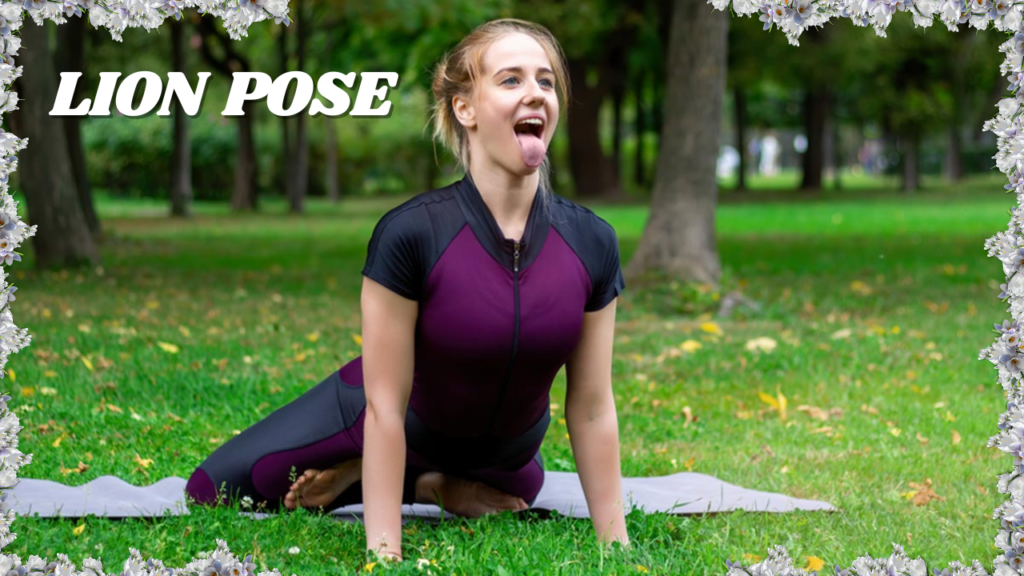Welcome, yoga enthusiasts and curious beginners! Today, let’s explore the lion yoga pose, also known as Simhasana. This unique pose is not merely about assuming a posture; it’s about embodying the fierce spirit of a lion with a powerful roar that helps release stress and energizes your entire body. Ready to roar and let go of the tension?

What is the Lion Yoga Pose?
Simhasana, or the lion yoga pose, is a dynamic seated asana where you mimic the facial expressions and the roar of a lion. This pose is distinguished by its active use of facial muscles and the vocal projection of a roar, making it a standout in yoga practices focused on quietness and meditative silence. It serves as a powerful way to release tension and invigorate your practice with energy.
Origins of Simhasana
The lion pose draws its inspiration from the majestic lion, symbolizing power and confidence in various Eastern traditions. Historically, this pose is believed to drive away fear and negative energy, empowering practitioners with the courage and self-assurance of a lion. It’s more than just a physical exercise; it’s a practice in building inner strength and fortitude.
How to Perform the Lion Pose
To correctly perform the lion pose:
- Sit with your hips on your heels, a traditional kneeling position that provides a stable base.
- Position your hands on your knees with fingers spread wide to mimic a lion’s paws, adding to the authenticity of the pose.
- Inhale deeply, then exhale with a forceful roar, extending your tongue out to increase the stretch in your facial muscles and throat.
- Repeat the action, each time focusing on the intensity of the roar and the stretch.
Curious about more yoga poses? Check out our detailed guide on “Gate Pose Yoga” for another enriching addition to your practice!
Physical Benefits of Lion Pose
Practicing the lion pose offers several tangible benefits:
- Facial rejuvenation: Activating the muscles in your face can help keep them firm and youthful.
- Tension release: Particularly effective for those who experience stress-induced tightness in the face and chest.
- Breath enhancement: The forceful breathing technique used in this pose helps increase lung capacity and strengthens your diaphragm.
Mental and Emotional Perks
Simhasana is a boon for mental health, offering benefits that extend well beyond the physical:
- Eases stress: The act of roaring is profoundly liberating and can dramatically reduce stress levels.
- Boosts concentration: By focusing intensely on the pose and the roar, you can enhance your overall mental clarity and focus.
Common Mistakes to Avoid
When practicing the lion pose, ensure not to:
- Hold back the roar: The therapeutic benefits of Simhasana come from the powerful roar, so give it your all.
- Ignore your posture: Maintaining a strong, upright spine is crucial for the effectiveness of the pose.
Who Should Do It and Who Shouldn’t
While the lion pose is generally safe for most, individuals with significant knee problems or those who find sitting back on their heels uncomfortable should approach this pose with caution or seek alternative poses that don’t strain the knees.
Curious about more yoga poses? Check out our detailed guide on “Grasshopper Yoga Pose” for another enriching addition to your practice
Incorporating Lion Pose into Your Routine
Simhasana can be seamlessly integrated into any part of your yoga routine. It serves as an excellent transitional pose or a dynamic conclusion to release any lingering stress and re-energize your body after a session.
Tips for Mastering Simhasana
To get the most out of the lion pose:
- Embrace the sound: The louder and more powerful your roar, the greater the release of tension.
- Engage your gaze: Directing your eyes upwards or into the middle distance can help deepen your focus and intensify the pose.
The Emotional Release of Roaring
The act of roaring in Simhasana taps into primal energies and emotions, allowing for an exhilarating release of suppressed feelings. This can lead to emotional breakthroughs and a renewed sense of personal power.
Kids and Lion Pose
Children are naturally drawn to the playful aspect of Simhasana, making it an excellent tool for introducing them to yoga. It allows them to express themselves loudly in a controlled environment, helping them connect with their bodies in a fun and engaging way.
Curious about more yoga poses? Check out our detailed guide on “Wheel Yoga Pose” for another enriching addition to your practice!
Advanced Variations
For those who are comfortable with the basic pose and looking for more challenge:
- Alter your seating: Try sitting in a cross-legged position to change the base of the pose.
- Vary your roars: Experimenting with different sounds and volumes can make the pose more challenging and fun.
Conclusion
Embracing the lion yoga pose is about much more than stretching and roaring; it’s about tapping into a deeper sense of personal power and emotional freedom. Here are the key takeaways:
- Let your roar be heard: Embrace the power of your voice to release tension.
- Fully engage: Use your entire body and spirit to embody the pose.
- Enjoy the practice: Allow yourself to have fun and be playful with this powerful pose.
Have you ever given the lion pose a try in your yoga practice? What changes did you notice in your body and mind afterward? Share your experiences and let’s keep the conversation going!